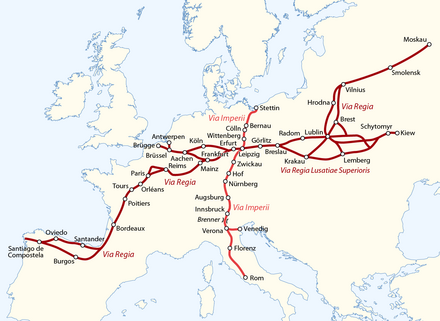Korchak (place)
| Korchak | ||
| Корчак | ||

|
|
|
| Basic data | ||
|---|---|---|
| Oblast : | Zhytomyr | |
| Rajon : | Zhytomyr district | |
| Height : | 206 m | |
| Area : | 1.416 km² | |
| Residents : | 389 (2015) | |
| Population density : | 275 inhabitants per km² | |
| Postcodes : | 12421 | |
| Area code : | +380 412 | |
| Geographic location : | 50 ° 13 ' N , 28 ° 29' E | |
| KOATUU : | 1822083801 | |
| Administrative structure : | 1 village | |
| Address: | вул. Шевченка 25 12421 с. Тетерівка |
|
| Website : | http://teterivska.gromada.org.ua/ | |
| Statistical information | ||
|
|
||
Kortschak ( Ukrainian and Russian Корчак , Polish Korczak ) is a village in northern Ukraine in the Zhytomyr Oblast and the Rajon of the same name .
geography
Korchak is located in the middle of an undulating landscape in the north of the Dnieper highlands on the left bank of the Teteriv river , which flows into the Dnepr , which is dammed up to the Kiev reservoir . Administratively, the place and 10 other villages have belonged to the rural municipality of Teteriwka since 2015 . At the beginning of 2015 there were 389 inhabitants in the village.
geology
From a geological point of view, the region lies on the Ukrainian shield in the south of the Eastern European plain .
traffic
Korchak is located 15 kilometers southwest of Zhytomyr . The N 03 Zhytomyr – Chernivtsi highway runs through the village . The Ukrainian capital Kiev is 156 kilometers away from Korchak. Three airports have been built in the Kiev catchment area, the largest being Kiev-Boryspil Airport .
history

The region was originally inhabited by the East Slav Polans . After the baptism of Vladimir I. on July 28, 988 which took place Christianization of Kievan Rus . After the Eastern Schism in 1054, the area stayed with the Russian Orthodox Church and adopted the Cyrillic alphabet . In 1320 Korchak belonged to Lithuania and in 1569 came to the united Kingdom of Poland-Lithuania . After the uprising of the Zaporozhian Cossacks against Polish rule, the area was subordinated to the ataman Bohdan Khmelnyzkyj for several years from 1648 . After the Treaty of Perejaslav in 1654, the hetmanate was annexed to the Russian Empire and Zhytomyr was designated the seat of the Kiev Voivodeship . With the Second Partition of Poland , Kortschak came to the tsarist empire in 1793 and was in the Volhynian governorate . After the October Revolution of 1917, the Ukrainian People's Republic was proclaimed in January 1918 . After the establishment of the Soviet Union in December 1922, the Ukrainian SSR was established. Several million Ukrainians died in the Holodomor of 1932/33 .
After the attack by the Wehrmacht on the Soviet Union , Kortschak was in the general district of Zhitomir from 1941 to 1944 , which was part of the German Reich Commissioner for Ukraine . In the course of the Great Patriotic War of 1943/44, fierce fighting broke out between the German Wehrmacht and the Red Army in the greater Zhytomyr area . On October 24, 1945, the Ukrainian SSR became a member of the United Nations .
After the dissolution of the Soviet Union and the referendum on independence , Ukraine became an independent state in 1991.
Archaeological site
There was an archaeological site in Korchak. The early Slavic Korchak group was named after this, an archaeological culture that developed from the Kiev culture . The excavations were directed in the 1950s by the Moscow historian and archaeologist Jurij V. Kucharenko (Russian: Юрий Владимирович Кухаренко). The Luka Rajky culture emerged from the Korchak group .
Individual evidence
- ↑ http://w1.c1.rada.gov.ua/pls/z7503/A036?vf7551=1988
- ↑ Тетерівська громада - Житомирський район. January 1, 2015, accessed November 5, 2016 (Ukrainian).
- ↑ Чесноков Алексей Николаевич: КУХАРЕНКО ЮРИЙ ВЛАДИМИРОВИЧ - российский археолог. Retrieved November 5, 2016 (Russian).

